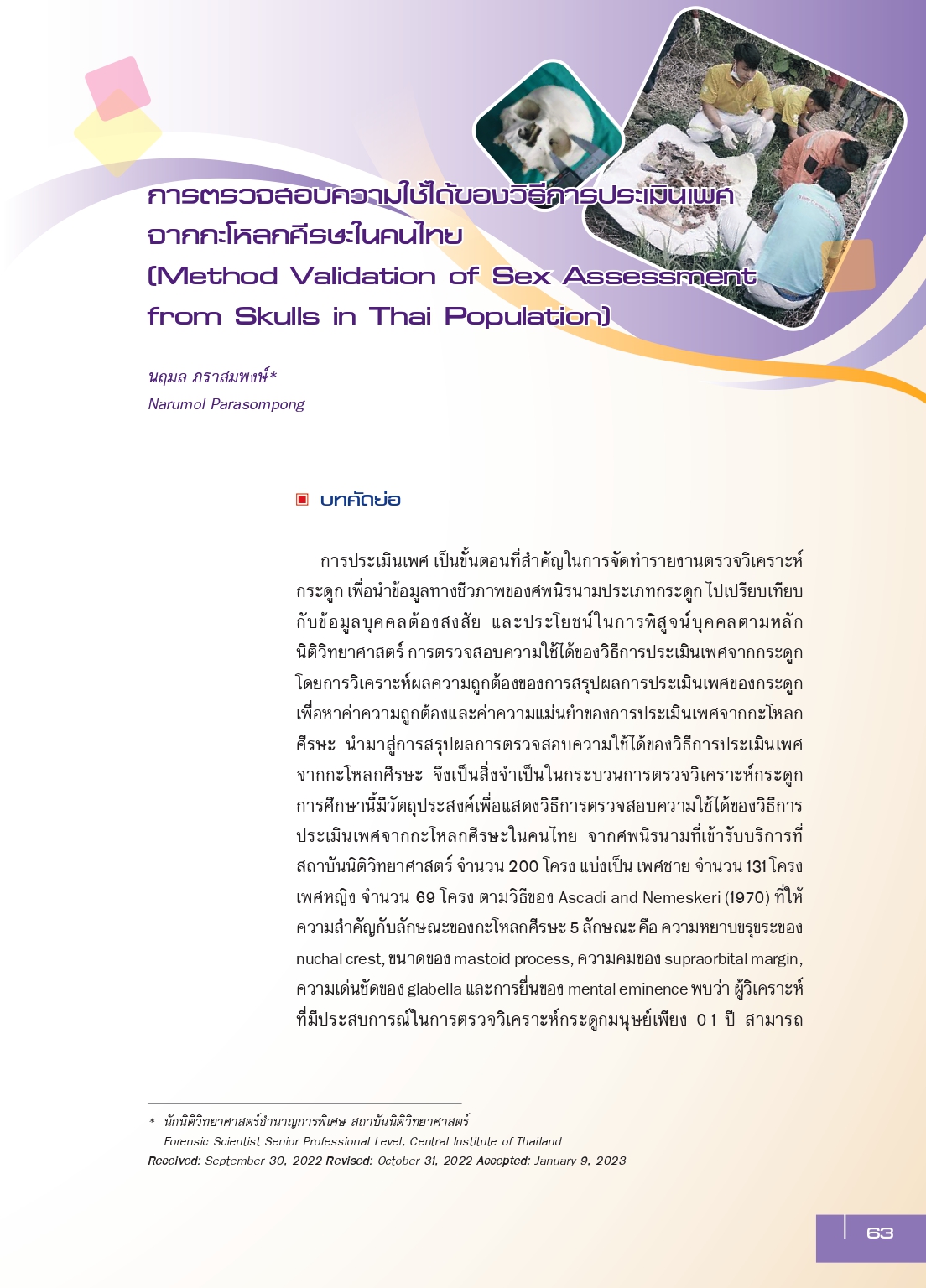การตรวจสอบความใช้ได้ของวิธีการประเมินเพศจากกะโหลกศีรษะในคนไทย
Main Article Content
บทคัดย่อ
การประเมินเพศ เป็นขั้นตอนที่สำคัญในการจัดทำรายงานตรวจวิเคราะห์กระดูก เพื่อนำข้อมูลทางชีวภาพของศพนิรนามประเภทกระดูก ไปเปรียบเทียบกับข้อมูลบุคคลต้องสงสัย และประโยชน์ในการพิสูจน์บุคคลตามหลักนิติวิทยาศาสตร์ การตรวจสอบความใช้ได้ของวิธีการประเมินเพศจากกระดูก โดยการวิเคราะห์ผลความถูกต้องของการสรุปผลการประเมินเพศของกระดูก เพื่อหาค่าความถูกต้องและค่าความแม่นยำของการประเมินเพศจากกะโหลกศีรษะ นำมาสู่การสรุปผลการตรวจสอบความใช้ได้ของวิธีการประเมินเพศจากกะโหลกศีรษะ จึงเป็นสิ่งจำเป็นในกระบวนการตรวจวิเคราะห์กระดูก การศึกษานี้มีวัตถุประสงค์เพื่อแสดงวิธีการตรวจสอบความใช้ได้ของวิธีการประเมินเพศจากกะโหลกศีรษะในคนไทย จากศพนิรนามที่เข้ารับบริการที่สถาบันนิติวิทยาศาสตร์ จำนวน 200 โครง แบ่งเป็น เพศชาย จำนวน 131 โครง เพศหญิง จำนวน 69 โครง ตามวิธีของ Ascadi and Nemeskeri (1970) ที่ให้ความสำคัญกับลักษณะของกะโหลกศีรษะ 5 ลักษณะ คือ ความหยาบขรุขระของ nuchal crest, ขนาดของ mastoid process, ความคมของ supraorbital margin, ความเด่นชัดของ glabella และการยื่นของ mental eminence พบว่า ผู้วิเคราะห์ที่มีประสบการณ์ในการตรวจวิเคราะห์กระดูกมนุษย์เพียง 0-1 ปี สามารถประเมินเพศจากกะโหลกศีรษะได้ถูกต้อง ในช่วงร้อยละ 72-74.5 ในขณะที่ ผู้วิเคราะห์ที่มีประสบการณ์ในการตรวจวิเคราะห์กระดูกมนุษย์ ตั้งแต่ 6 ปีขึ้นไป สามารถประเมินเพศจากกะโหลกศีรษะได้ถูกต้อง ในช่วงร้อยละ 85.5-90 เมื่อนำมาทดสอบความใช้ได้ของวิธีโดยดูจากค่าความสอดคล้องระหว่างผู้ประเมิน พบว่า อยู่ในระดับดีถึงดีมาก แสดงว่าวิธีการประเมินเพศจากกะโหลกศีรษะ ด้วยวิธีการของ Ascadi and Nemeskeri (1970) ซึ่งศึกษาในกะโหลกศีรษะของชาวต่างชาติ สามารถนำมาใช้ประเมินเพศจากกะโหลกศีรษะของคนไทยได้
Article Details

อนุญาตภายใต้เงื่อนไข Creative Commons Attribution-NonCommercial-NoDerivatives 4.0 International License.
ต้นฉบับที่ได้รับการตีพิมพ์ในวารสาร เป็นลิขสิทธิ์ของวารสารกระบวนการยุติธรรม แต่ความคิดเห็นที่ปรากฏในเนื้อหาของบทความในวารสารกระบวนการยุติธรรม ถือเป็นความรับผิดชอบของผู้เขียนแต่เพียงผู้เดียว
เอกสารอ้างอิง
ประสบชัย พสุนนท์. (2558). การประเมินความเชื่อมั่นระหว่างผู้ประเมินโดยใช้สถิติแคปปา. วารสารวิชาการศิลปศาสตร์ประยุกต์, 8(1), 2-20.
สรรใจ แสงวิเชียร. (2541). กะโหลกคนไทย (การศึกษาทางมานุษยวิทยากายภาพ) ฐานข้อมูลมานุษยวิทยากายภาพในประเทศไทย. ค้นเมื่อ 2 มีนาคม 2561, จาก http://sac.or.th
Abdel, F. E. E., Shirley, N. R., Jantz, R. L., & Mahfouz, M. R. (2014). Improving sex estimation from crania using a novel three-dimentsional quantitative method. Journal of Forensic Sciences, 59 (3), 590-600.
Acsadi, G., & Nemeskeri J. (1970). History of human life span and mortality. Hungary: Akademiai Kiado.
Brown, P., & Coobool, C. (1989). A Morphological and metrical analysis of the crania, mandibles and dentitions of a prehistoric Australian human population. Canberra: Australian National University Press.
Buikstra, J. E, & Ubelaker, D. H. (1994). Standards for data collection from human skeletal remains. Arkansas: Arkansas Archeological Survey Research Series.
Duangto, P., Mahiphot, J., Chompoopheun, H., & Mahakkanukrauh, P. (2014). Sexdetermination from metopic suture and supraorbital ridge in Thai population. Chiang Mai Medical Journal, 53(4), 181-186.
Duric, M., Rakocevic, Z., & Donic, D. (2005). The reliability of sex determination of skeletons from forensic context in the Balkans. Journal of Forensic Sciences, 147(2), 159-164.
Fleiss, J. L., Levin, B., & Paik, M. C. (2003). Statistical methods for rates and proportions (3rd ed.). New Jersey: John Willey & Sons.
Garvin. H.M., & Ruff. C. B. (2012). Sexual Dimorphism in Sketal Browridge and Chin Morphologles Determinined Using a New Quamirative Method. American Journal of Physical Anthroplogy,147(4), 661-670.
Garvin, H. M., Sholts, S. B., & Mosca, L. A. (2014). Sexual dimorphism in human cranial trait scores: effects of population, age, and body size. The American Journal of Physical Anthropology, 154 (2), 259-269.
Giles, E. (1970). Discriminant functions sexing of the human skeleton. In: Stewart T. D (Ed). Personal identification in mass disasters, National Museum of Natural History. Washington. n.p.
Keen, J. A. (1950). A study of the differences between male and female skulls. The American Journal of Physical Anthropology, 8(1), 65-79.
Konigsberg, L. W., & Hens, S. M. (1998). Use of ordinal categorical variables in skeletal assessment of sex from the cranium. American Journal of Physical Anthropology, 107(1), 97-112.
Langley, N. R., Dudzik, B., & Cloutier, A. (2017). A decision tree for nonmetric sex assessment from the skull. Journal of Forensic Sciences, 63(1), 1-7.
Langley, N. R., & Tersigni-Tarrant, M. A. (2017). Forensic anthropology a comprehensive Introduction (2nd ed.). New York: CRC Press Taylor & Fronscis Group.
Larnach, S. L., & Macintosh, N. W. G. (1971). The Mandible in Eastern Australian Aborigines. Sydney: Oceania Monographs No. 17. Sydney: University of Sydney.
Reichs, K. .J, & Bass, W. M. (1998). Forensic osteology advances in the identification of human remains (2nd ed.). Illinois: Charles C. Thomas.
Sakaue, K. (2004). Sexual determination of long bone in recent Japanese. Anthropological Science, 112(1), 75-81.
Sangvichien, S., Boonkaew, K., Chuncharunee, A., Komoltri, C., Udom, C., & Chandee, T. (2008). Accuracy of Cranial and Mandible
Morphological Traits for Sex Determination in Thais. Siriraj Medical Journal, 60(5), 240-243.
Sejren, B., Lynnerup, N., & Hejmadi, M. (2005). An historical skull collection and its use in forensic odontology and anthropology. Journal of Forensic Odonto-Stomatology, 23(2), 40-44.
Steyn, M., & Iscan, M. Y. (1997). Sex determination from the femur and tibia in South African whites. Forensic Science International, 90(1-2), 111-119.
Steyn, M., & Iscan, M. Y. (1998). Sexual dimorphism in the crania and mandibles of South African whites. Forensic Science International, 98(1-2), 9-16.
Texeira, W. R. G. (1982). Sex identification utilizing the foramen magnum’s size. The American Journal of Forensic Medicine and Pathology, 3(3), 203-206.


